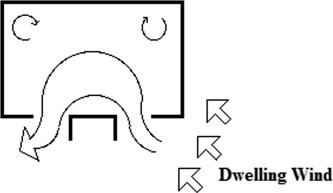Ventilation
Ventilation is basically introducing fresh air into the building, to cool the building using convection
Refrigerators
- Refrigerators act as heat pumps that transfer heat energy from the target environment to the “exhaust”, or the external environment
- Here the coolant (low boiling point liquid) is pumped in the coils in the environment that is to be cooled
- Heat is transferred from the target environment to the coolant (conduction).
- This causes the coolant to evaporate and thus the environment’s temperature decreases (cooling effect)
- The gaseous coolant is now transferred to an external environment (one not in contact with the target)
- Heat is transferred from the coolant to the external environment (radiation/conduction)
- The coolant condenses to a liquid phase and is recycled
- Heat is thus transferred out from the target environment into the external environment
- Refrigerators do not have a fan’s regulating air flow
Solar Energy
- Most devices that convert solar energy to heat, use solar collectors
- Solar collector: device that collects and/or concentrates solar radiation from the Sun
- For example, a light focus collector, which reflects the Sun’s rays to the target substance
- Multiple types of solar collectors
- Basic principle: Use radiation to heat up an integrated water system
- Heated water is used for personal use, or is heated sufficiently to convert it into steam that can be used to generate electricity by powering the turbine of an electric generator
- EMR from the Sun incidents on a solar heater and is reflected by reflective panels towards water piping that passes in between the solar collectors
- The EMR is absorbed by the water piping (radiation) and thus heat flows from the sun to the water piping
- By conduction, heat is transferred from the piping to water flowing inside the piping (as there is contact between the two sources)
- Thus as total internal energy of the system increases due to inwards flow of heat, the temperature increases as the average kinetic energy of the particles increases
Passive Solar Design
- Homes are made to collect, store, reflect, and distribute solar energy, in the form of heat in the winter and reject solar heat in the summer.
Passive Heating (during winter)
- The collection of solar energy through properly-oriented, south-facing windows.
- The storage of this energy in “thermal mass,” comprised of building materials with high heat capacity such as concrete slabs, brick walls, or tile floors.
- The natural distribution of the stored solar energy back to the living space, when required, through the mechanisms of natural convection and radiation.
- Window specifications to allow higher solar heat gain coefficient in south glazing.
- Double Glazing
- Insulating glass, more commonly known as double glazing, consists of two or more glass window panes separated by a vacuum or gas filled space to reduce heat transfer across a part of the building envelope. The trapped air prevents direct conductive heat loss between the air and the glass panels.
- Carpet & Concrete Floor
- Carpets reduce the amount of heat loss by conduction to the floor/windows. They can do this as they are poor conductors of heat.
- Wall Cavity
- Double walls on the perimeter of a house provide an air cavity which functions very similarly to double glazing. Here the air prevents direct conductive heat loss between the wall and the external environment.
- Fibreglass Insulation
- Fibreglass insulation comprises of a spongy material with a large amount of air trapped inside the material. This air prevents the loss of heat from the ceiling etc as air is a poor conductor of heat
Passive Cooling (during summer)
- Ventilation (lets hot air out through convection)
- Wing Walls
- vertical solid panels installed alongside windows transverse to the wall on the windward side
- increases the speed of the natural wind and subsequently improves the cooling effect inside the house.

- Thermal Chimney
- It draws air out of the structure using convective currents.
- Air can be drawn inside the building by generating a hot or warm zone with an exterior exhaust, hence ventilating the structure
- Thermal Mass
- The function of thermal mass is absorbing heat during days to moderate internal temperature.
- During nights, thermal mass is cooled through the use of ventilation.
- This makes the thermal mass ready for the next hot days to absorb heat and avoid the rise of temperature in the living space.
- Insulation
- Keeps cold air in, and hot air out
- Prevents loss of heat through conduction
- Earth Coupling
- Draws up the stable, deeper ground temperature to the floor’s surface, providing the building a head start to regulate temperature.
- Uses conduction
- Shading/Glazing
- Shading reduces the amount of sunlight you receive
- Glazing reduces the amount of solar radiation, by darkening the window
- Landscape
- E.g., trees/gardens can reduce hot air into buildings
Engine Cooling Systems
- Fuel combustion releases chemical energy that heat transfers throughout the gas in a cylinder.
- This increases the gas temperature, which in turn increases the pressure of the gas and, therefore, the force it exerts on a movable piston.
- The gas does work on the outside world, as this force moves the piston through some distance.
- Thus, heat transfer of energy to the gas in the cylinder results in work being done.
- To cool the engine down so that it doesn’t damage the engine, coolant liquid (usually water mixed with an antifreeze solution ) is circulated through special cooling passages, cooling the engine through conduction.
- The coolant is then passed through the radiator, which exposed the coolant to water, and thus cools it down through conduction
- Some engines are cooled by air flowing over finned cylinder casings
- Convection/Conduction
- This process uses conduction to do this